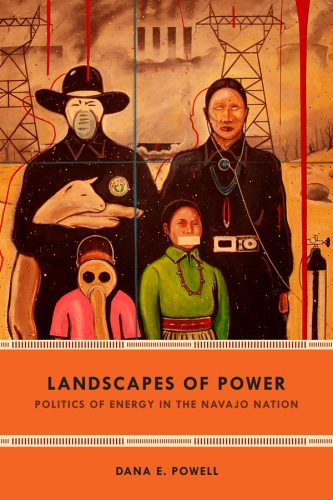In Landscapes of Power, Dana Powell maps a failure: the proposed Desert Rock power plant which never came into being beyond paper thin promises made via PowerPoint presentations. Yet Powell traces its seismic impacts across energy policy, activism, and art in the Navajo Nation. The shifting dynamics of relative power and powerlessness drive her analysis of a project-in-becoming that offered sugared seduction known as “development,” yet threatened a way of living rooted in the landscape powered by those social arrangements that in the development lens are viewed as deprivation.
It is a failure because Desert Rock never came into being, however the double bind of extraction burden and resource depletion continues to fall on Dinétah (the word in the Navajo language for the traditional homeland of the Navajo people) through the inequitable relations of settler colonialism. It is the continuous contours of this landscape of power, so well-drawn by Powell, that I focus on in this review, drawing inspiration from my own continuing anthropological research on climate change in Northern Arizona and from my field site in the rural area located in the south of the Grand Canyon and in the west of the Navajo Nation.
The tension between environmental justice and energy sovereignty plays out in ways specific to Diné, with more at stake than how the lights are powered.
 The double bind that Powell describes, in which Navajo lands are polluted through resource extraction yet Navajo people do not benefit from the profits derived, disrupts the meanings of sovereignty in the context of energy policy. While tribal government figures see material benefits in controlling their own fossil fuel resources and pursuing deals with third-party corporations to extract them, for activists this continues practices that are environmentally degrading and undermine a rural way of life as well as Navajo philosophy. The tension between environmental justice and energy sovereignty plays out in ways specific to Diné, with more at stake than how the lights are powered. The rich history described by Powell of the resistance in the town of Burnham against a proposed coal mine in the 1970s, close to the subsequent proposed site of Desert Rock, acts as prolegomena to the later refusal. The enduring uncertainties of settler colonialism fueled both the Burnham coal wars and the resistance to Desert Rock are both fueled by the Navajo land is both sovereign and colonized: it is a nation state with its own powers to draw treaties and taxes, but it is also subject to the policies and regulations of the Bureau of Indian Affairs and the US federal government.
The double bind that Powell describes, in which Navajo lands are polluted through resource extraction yet Navajo people do not benefit from the profits derived, disrupts the meanings of sovereignty in the context of energy policy. While tribal government figures see material benefits in controlling their own fossil fuel resources and pursuing deals with third-party corporations to extract them, for activists this continues practices that are environmentally degrading and undermine a rural way of life as well as Navajo philosophy. The tension between environmental justice and energy sovereignty plays out in ways specific to Diné, with more at stake than how the lights are powered. The rich history described by Powell of the resistance in the town of Burnham against a proposed coal mine in the 1970s, close to the subsequent proposed site of Desert Rock, acts as prolegomena to the later refusal. The enduring uncertainties of settler colonialism fueled both the Burnham coal wars and the resistance to Desert Rock are both fueled by the Navajo land is both sovereign and colonized: it is a nation state with its own powers to draw treaties and taxes, but it is also subject to the policies and regulations of the Bureau of Indian Affairs and the US federal government.
Lakota Sioux scholar and activist, Vine Deloria, documents the reaction of white Americans upon learning the resource wealth controlled by sovereign tribes. Deloria explains how this information triggered demands for Lakota Sioux to be absorbed into mainstream society. Assimilation and appropriation undermine Indigenous legal rights to their ancestral lands so that those resources can be plundered (2003: 1-2). Sovereignty and resource extraction have always been entangled in settler colonialism. The western side of the Navajo Nation abuts the Grand Canyon on the Colorado Plateau, where uranium and coal have long been mined. Before the mouth of the Grand Canyon, near the town of Page and Lake Powell, is the Navajo Generating Station, a 2.25 gigawatt coal-fired power plant. It embodies the same poisoned sustenance that Desert Rock offered, being both dangerous to the health and environment of the area, and also a significant employer (83% of the plant employees are enrolled tribal members). Yet the power it generates is primarily used to fuel the Central Arizona Project. This hundreds-mile long pipeline takes water from the Colorado River, which carves the Grand Canyon, and delivers it to the desert-bound metropolises of Phoenix and Tucson. The Navajo Generating Station is a funnel for resources out of the Navajo Nation, benefitting the settler cities, leaving behind health problems and environmental damage, for a minority to have jobs. The activists that Powell quotes called the economic promise of Desert Rock “blood money” because of such tensions.
The provocative question that Powell raises is: how much do residents want the grid? Activism against Desert Rock was a rejection of fossil fuels, but a qualified one, and Powell neatly highlights the ambiguities of aligning Navajo activism with that of environmentalism.
The Navajo Generating Station is now at the end of its life. After 46 years of operation, the lease for the power station has been taken over by the Navajo Nation and it will be decommissioned. The Governor of Arizona, Doug Ducey, caused controversy in the final months of negotiations by trying to keep the plant open, in line with President Trump’s pro-coal policies, for example by exempting the plant’s coal from sales tax. But the plant was losing money, natural gas was cheaper, and the same force that animated opposition to Desert Rock, made it a losing proposition.
A new proposed hydroelectric power plant in Big Canyon, with dams on the Little Colorado, in May 2020 continues the corporate lures of development at the expense of public and ecological health. Yet development occurs in bubbles. In much of the Navajo Nation and the rural hinterlands of the Grand Canyon, many residences still have no access to power and remain off the grid. The provocative question that Powell raises is: how much do residents want the grid? Activism against Desert Rock was a rejection of fossil fuels, but a qualified one, and Powell neatly highlights the ambiguities of aligning Navajo activism with that of environmentalism.
In this book, Powell reveals that the fight against fossil fuels is not necessarily synonymous with climate activism. For the Navajo, the threat to a way of life was of equal importance to the aims of climate mitigation. This work is therefore an important contribution to the anthropology of climate change because it qualifies what is meant by such catch-all terms as ‘environmentalism’ and ‘climate justice’ in an indigenous context.
References
Vine Deloria, God is Red. Golden, Fulcrum Pub., 2003
Read Lena’s Gross’ review here.
Read Nimisha Thakur’s review here.
Featured Image by kasabubu, pixabay.com.



